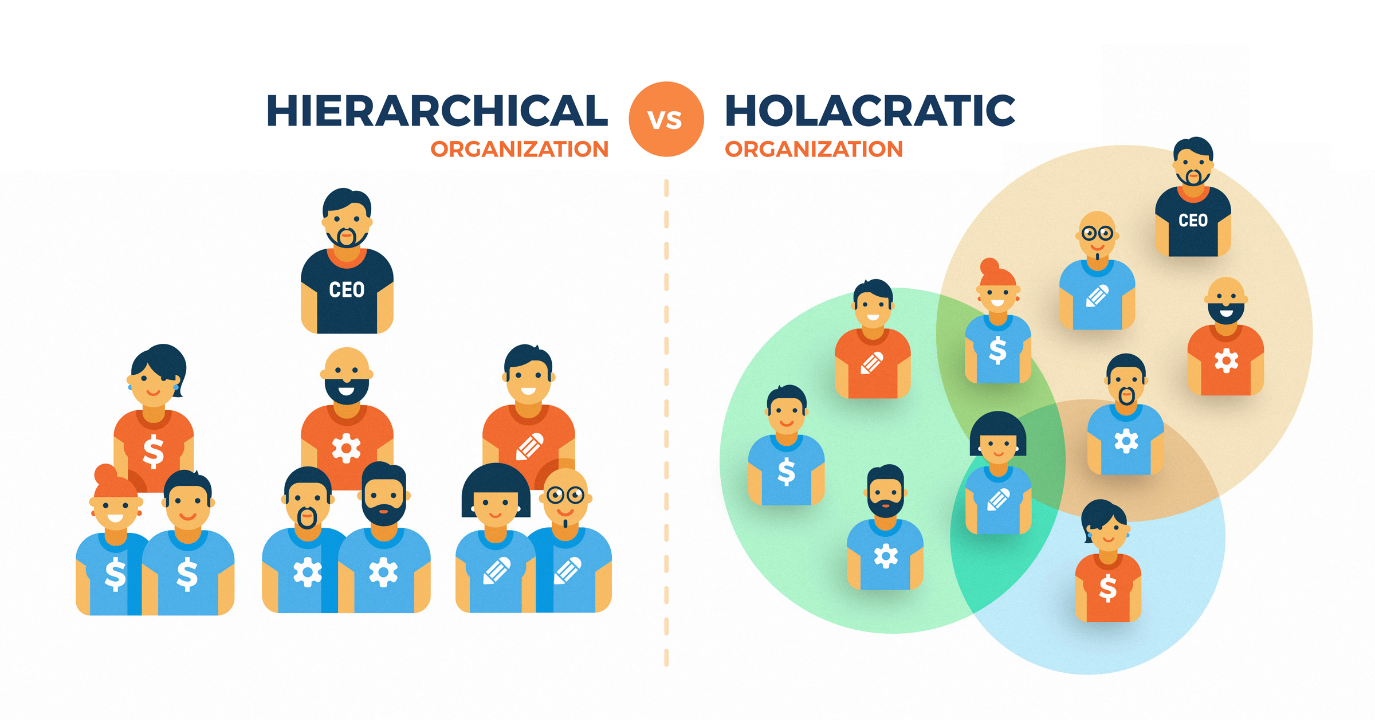Holacracy Hype in the Organizations
You reduce power in the organization and the performance power of the organization increases.
Who would say no to such a great covenant?
The face value of Holacracy has created such a hype and as we have entered into 2020, diving into the reality is necessary to avail an amazing transaction like this.
The term “Holacracy” precisely talks about the organizational structure which thoroughly influences two elementary understandings about an organization:
1. It has a top-down hierarchy
2. It has a need for management staff
It cannot be interpreted that Holacracy does not have a hierarchy or no authority but it focuses on goal alignment by introducing radical autonomy in the organization.
#Holacracy is claimed to increase agility, efficiency, transparency, innovation and accountability within an organization. The approach encourages individual team members to take initiative and gives them a process in which their concerns or ideas can be addressed.
In other terms, Holacracy reduces or leans the organizational structure to a flatter one along with eliminating the presence of managers. Now, the general notion in the mind is that if there are no managers, then there is no distribution of responsibilities in the organization and it is ultimately going to affect the productive response of the firm.
These interpretations can be changed by looking at what Holacracy promises:
- Transparent distribution of authority
- Goal-oriented work
- Highly influencing meetings
- Lean and compliant organization
The promises are fulfilled by the action and this would let us know how Holacracy works:
A. Organic vs artificial hierarchy:
As a traditional structure of the firm has hierarchies, Holacracy in its firm’s structure has ‘Holarchy’ which is a substitute of removing managers or levels in the firm and is a group of self-organizing team named as ‘circles’. Holacracy can be said as hierarchy of work instead of individual.

B. Roles over Job Titles:
The motive is to create an environment in which individuals do not have any Job Titles and Management Title. An individual with no job title has more probability to be highly focused on work. “Everyone becomes a leader of their roles and a follower of other”, thus, individual roles are the best.
C. Process:
A firm which has its employees more in touch with changing environment may become agile and open system leading to a state where agile process becomes the centre in the processing.
D. Meetings:
As there is no hierarchy, there are no managers to schedule the meeting. The members of the circle organize meetings to so as to effectively bring out the issues to be addressed and solved. In the company, there are a number of circles and they synchronize their information for meetings. Decisions are taken on the basis of the consensus.

Having known the concept, the next question that pops up in mind is that, “has Holacracy worked for firms in the way it was expected to?”
“Sometimes the conflicts we have in organizational life are actually clashes of the roles involved, but we mistake them for clashes between the people filling those roles.” - Brian J. Robertson
One example is Zappos.com which took the news and media to the storm when it implemented Holacracy in the organization. The company switched to this non-hierarchical structure but some of the employees who did not wish to be a part of this model were given a choice to choose severance and to the surprised, 14% of the employees accepted severance. But as it is required in every work, more interested the people are, more smoothly the company runs.

Holacracy has been introduced and implemented but there are certain views which say that Holacracy is still NOT the solution for organizations to work better and this is because of the following reasons:
- For almost all the organizations, especially the big ones, the problem is quite different from what Holacracy is supposed to solve. These organizations are able to distribute authorities and have their meetings arranged from time to time, but what they lack is the customer centric view in their processes. They focus on the internal efficiency of the organization and loose their focus on customers’ needs.
- The changes in the organization say that the authority is now not in hand of manager but when the structure is changed, employees already know who is going to be the authoritative person in the circle and take the decision as people say, ‘there has to be a leader’ and this demotivates employees to stay in the model.
The fact that Holacracy is introduced to the organization cannot be denied but its implementation needs to be taken care of. Organization already existing in the traditional structure would find it difficult to switch into this model. Small and young organizations or startups would be the best to allow Holacracy into the organization and make themselves as the critical point to bring this model into the organizations... and perhaps, shape the #FutureOfWork
Posted in : Future of Work
Views : 20421
Leave a Comment
Hey there !
Author Details
Related Blogs
Popular Tags
Subscribe Now

Related Blogs
More fromFuture of Work





